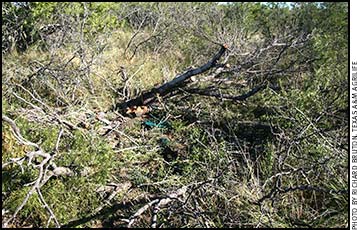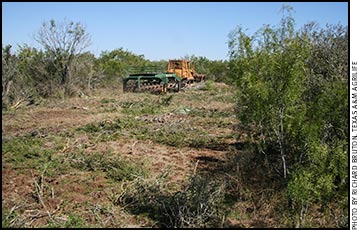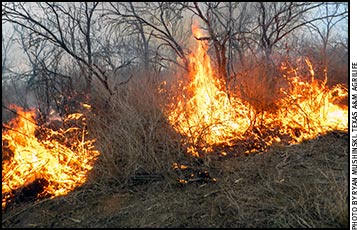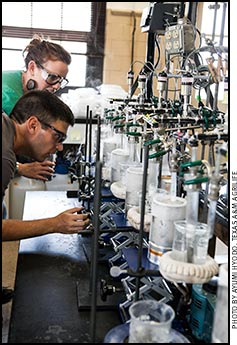Refill the Aquifer
Texas A&M researchers determine best range management practices
for aquifer recharge.

In the cut-stump treatment (the blue dye from the herbicide is visible on stumps), all above-ground woody vegetation was removed by chainsaws and then herbicide was applied to the stump.
Water recharge to an aquifer is highly dependent on vegetation and soil type, but what are the best management practices for landowners to ensure maximum environmental returns and economical livestock and wildlife production?
Team members from Texas A&M University’s ecosystem science and management department and the Texas A&M AgriLife Extension Service are working to answer that question with the “Effects of Brush Removal on Distributed Recharge of the Carrizo‐Wilcox Aquifer” project, funded by the Wintergarden Groundwater Conservation District.
Study specs
Jason West, assistant professor, and Bill Rogers, associate professor, both in the ecosystem science and management department, and Bob Lyons, AgriLife Extension range specialist in Uvalde, are studying the effectiveness of vegetation removal and how different soils respond to the removal.

The roller-chopping site showed significant impact on above-ground woody vegetation, as well as on the herbaceous vegetation in areas impacted by the aerator teeth.
The land-management techniques being evaluated are prescribed fire and its interaction with chainsaw/herbicide and roller chopping, West said. The project’s goal is to study the interactions of prescribed fire, commonly utilized mechanical treatments and dominant recharge-zone soil types in affecting plant community and soil hydrologic processes.
It is important to understand how these removal strategies impact the plant communities critical to economically viable rangeland enterprises, West said. Simultaneously, they are comparing the effects of these management strategies on groundwater recharge processes.
“Natural resource and conservation managers are increasingly being asked to maximize the production and sustainability of multiple environmental services,” he said.
While research exists comparing the effects of different fire, mechanical and chemical treatments on aboveground and belowground dynamics, few studies have simultaneously compared the responses of plants, soils and hydrology to these brush-removal strategies, West said.

Prescribed fire was used on one of the plots that received neither cut-stump nor roller-chopping treatment, thus retaining the highest fuel load.
Such studies are critical if landowners are to decide which strategies are most beneficial in restoring environmental services, he said. For example, when soil-water recharge is a goal, it is important to document how strategies to increase recharge also impact the plant community essential to a profitable livestock and wildlife enterprise.
While prescribed fire is a frequently used tool for maintaining grasslands and savannas in many areas of central and south Texas, little information is available regarding how it alters the structure and composition of the plant community and how that may impact hydrologic processes, he said.
Observations of treatment responses began in spring 2011 and are still being monitored, he said. The observation period included a severe drought, with precipitation measured at the project field site from April 2011 through August 2012 being only about 75% of normal.

April Mattox, master’s student, and Brandon Cawthon, undergraduate worker, are extracting water from soils for stable isotope analysis in the Texas A&M University stable isotope laboratory.
Observations using stable water isotopes and soil coring indicate the dominant woody vegetation of the Carrizo‐Wilcox aquifer-recharge zone accesses soil moisture primarily in the top 6 feet of soil, with some indication that plants rarely access deeper water and perhaps only on coarse‐textured soils. On the rare occasions water moves below that depth, it is potentially available for aquifer recharge, he said.
Effects on vegetation
Brush control techniques have significantly different effects on both woody and herbaceous vegetation, West said. They saw high woody/low herbaceous mortality in cut‐stump treatments compared to moderate woody/high herbaceous mortality in roller‐chop treatments.
These brush-control effects on vegetation had significant consequences for soil-moisture profiles, with these also being strongly dependent on soil texture, he said.
With renewed funding from the Wintergarden Groundwater Conservation District, West and colleagues will continue to monitor these responses and assess the impacts of the prescribed burns recently completed.
During the period of observation, there was no direct evidence of potential recharge in any of the plots, due at least in part to the low precipitation during the study period, West said. However, differences across soil types in soil-moisture fluctuations and in response to the treatments suggest the possibility for brush-control‐induced recharge on the sandier soils with higher soil moisture contents.
Editor’s Note: This article is from the Texas AgriLife Communications Service.











